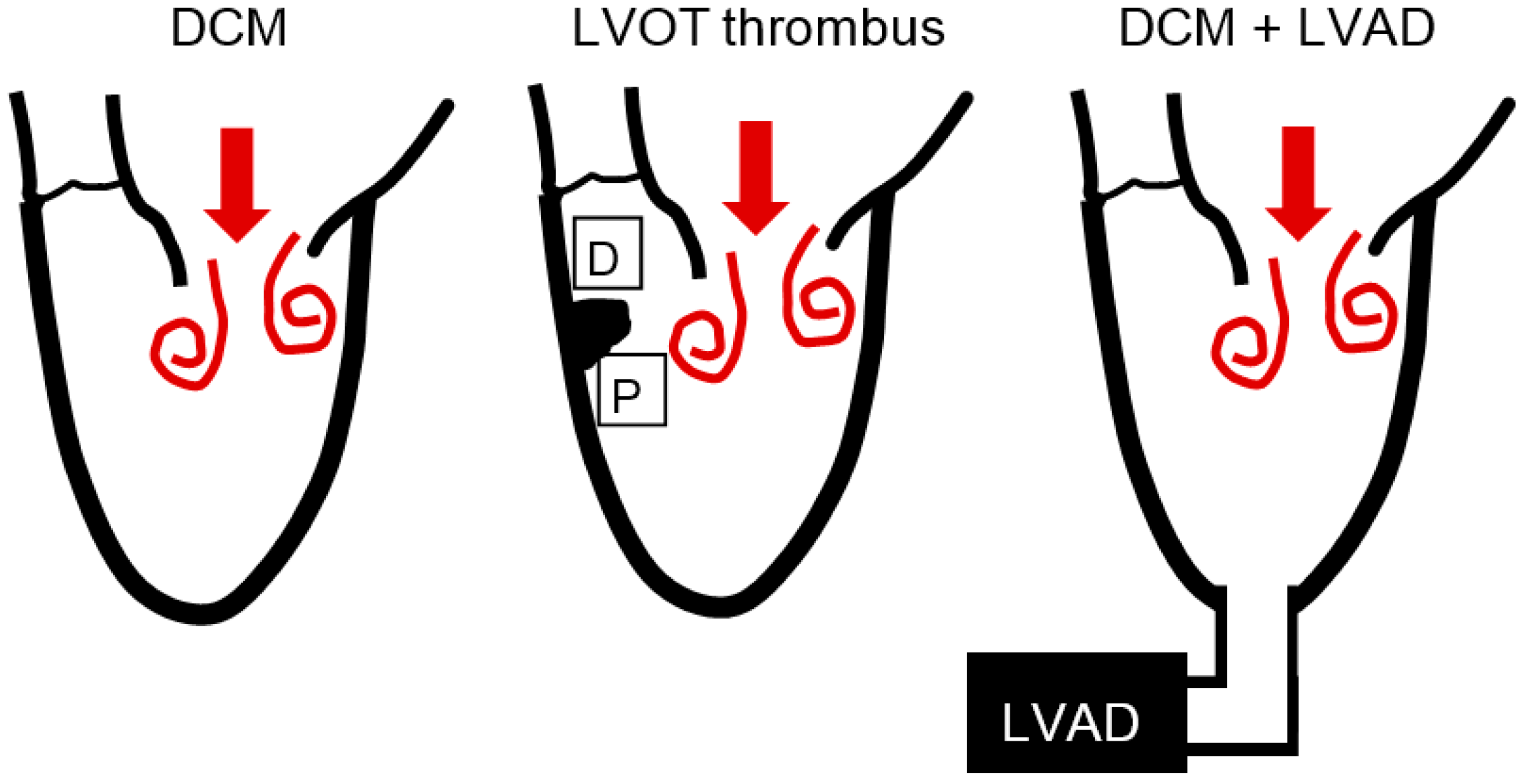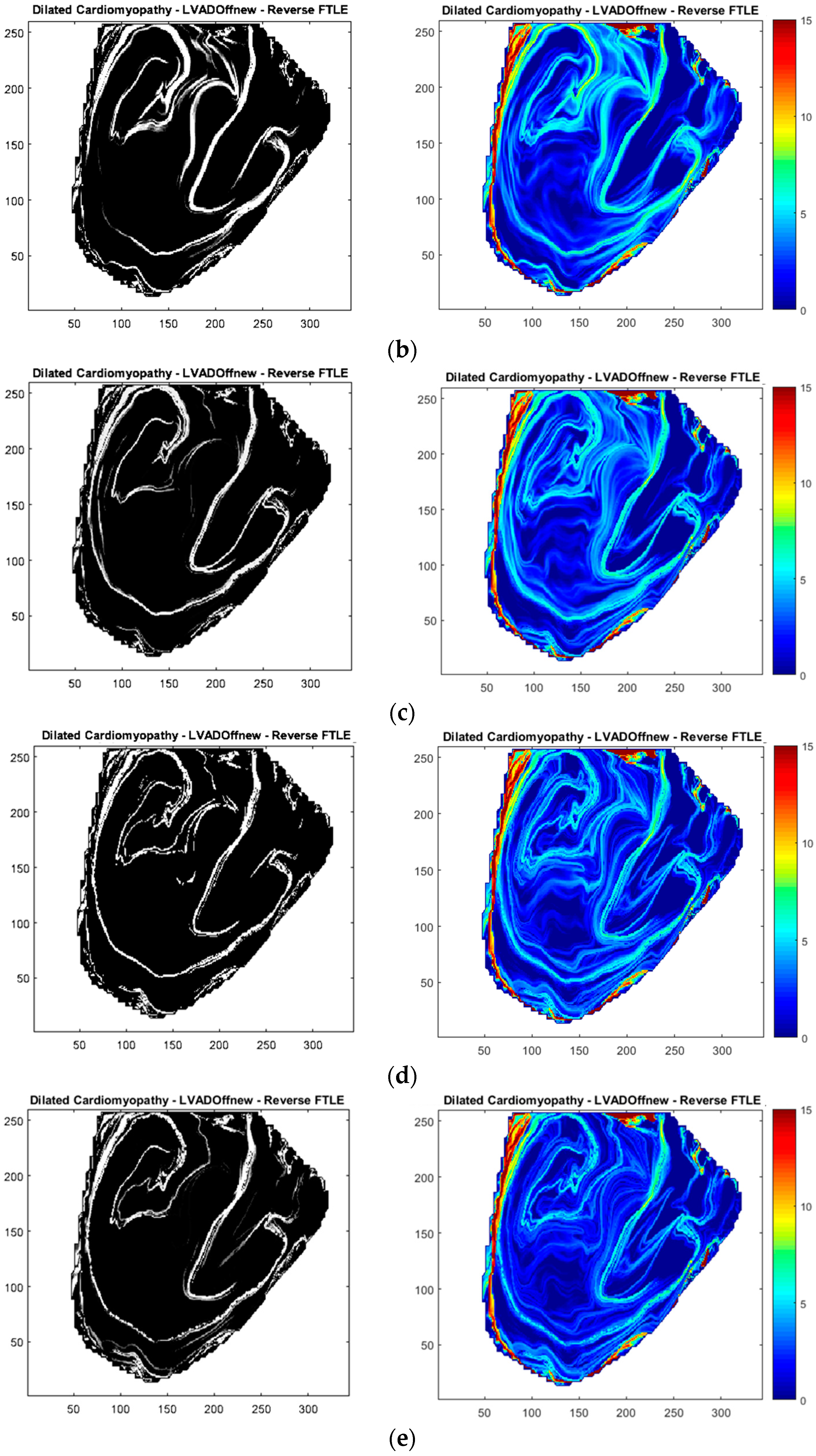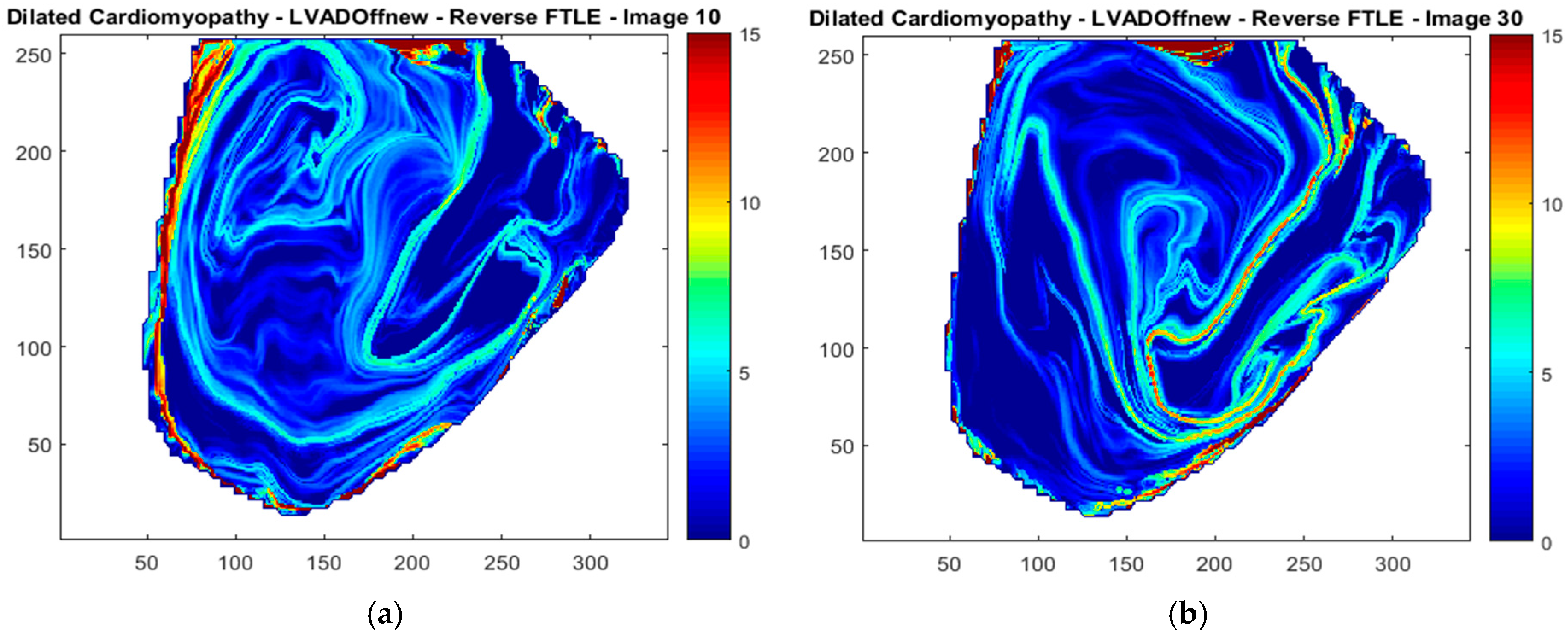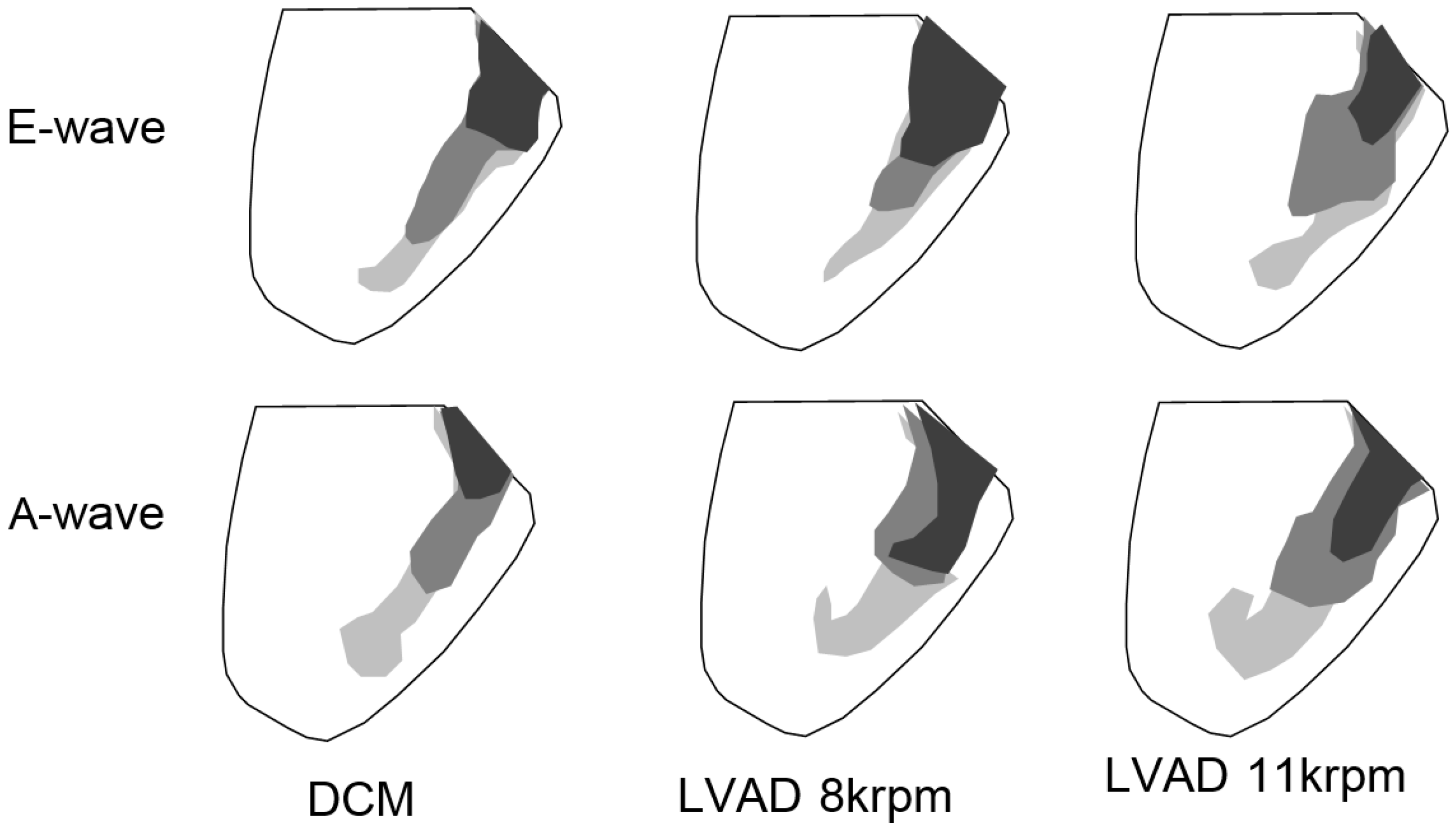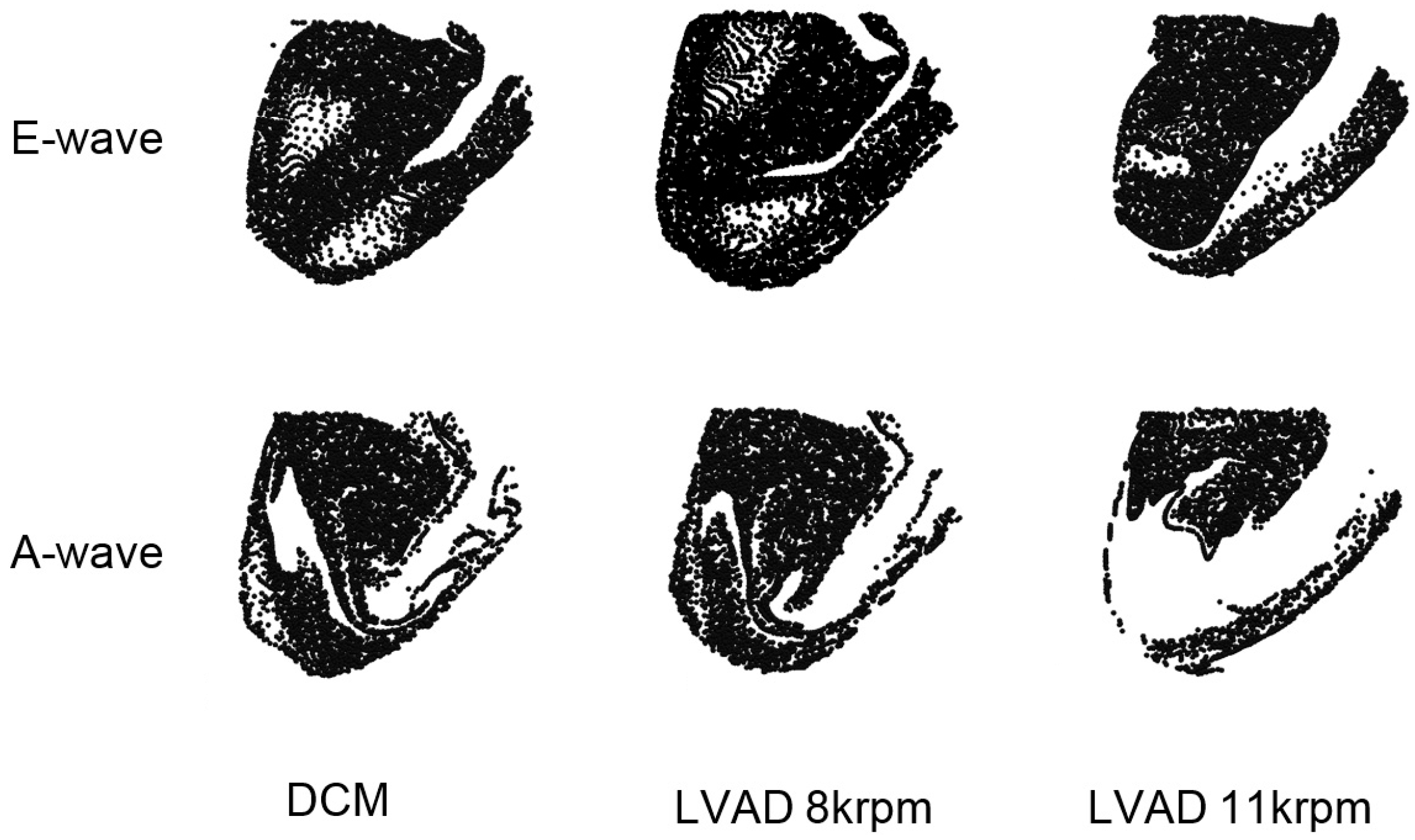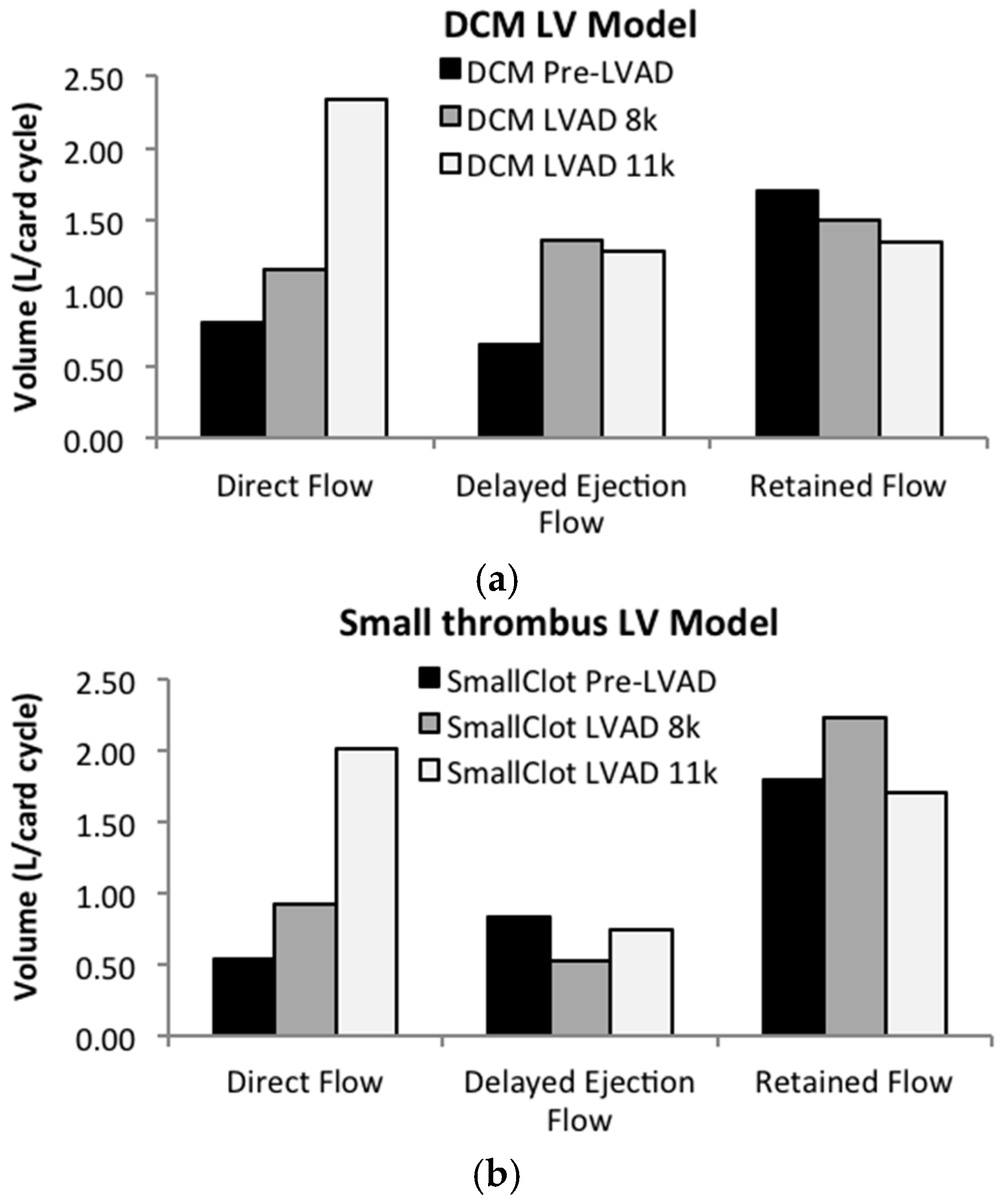1. Introduction
Blood-contacting medical devices, such as those that interface with the cardiovascular system, have continued to manifest significant stroke and thromboembolic event rates despite advances in design and medical management. These statistics drive the search for better tools to predict thrombus formation during the development phase of these devices, in order to better position the designs for long-term clinical success. Thrombus formation is difficult to model mathematically, due to the complicated underlying mechanobiology. Virchow’s triad first identified flow as a major factor affecting thromboembolism (TE). Flow affects the local concentrations of coagulation cascade factors, which impacts the activation, aggregation and deposition of platelets that initiate a thrombus. Flow determines where a thrombus will form, its size and composition, and whether or not it will remain attached or embolize. Mechanical shear is the main signal for platelet activation, and has been studied under conditions that simulate the physiological and pathological range.
Many approaches to modeling TE have included mathematical descriptions of the biochemical coagulation cascade, relating the flow pattern to component concentrations and shear-induced platelet activation [
1,
2]. Mechanistic models have been successfully applied to the design optimization of medical devices such as heart valves, ventricular assist devices, and vascular grafts [
3,
4]. These models yield insight into the relationship of flow patterns with thrombus formation and growth, but are computationally expensive and often require data that are not available on a patient-by-patient basis. Alternatives to these models are sought that can be implemented with a lower computational cost for rapid feedback in a clinical or engineering setting, with the goal of informing physicians on relative TE risk for specific patients to aid in making treatment decisions.
One approach used successfully for evaluating complex flow fields in cardiovascular medicine is the analysis of Lagrangian Coherent Structures (LCS), which are flow structures that bound transport within a flow field, and are defined as the maximally attracting/repelling material surfaces [
5,
6,
7] which locally maximize shear [
7]. As material surfaces, there is no flux across an LCS, and hence LCS can divide a flow into regions with disparate properties. Attracting LCS enable assessment of blood clearance and regions of flow stasis in the flow, and repelling LCS are associated with fluid deformation of shear-sensitive blood elements corresponding to lines of platelet activation [
8]. Our goal in this paper is to explore the application of LCS models for predicting transport and TE potential from velocity field data measured in an experimental model of the heart. Several clinical conditions are compared to understand the flow patterns in patients with dilated cardiomyopathy (DCM) before and after circulatory support with a left ventricular assist device (LVAD). In addition, a model of a patient left ventricle (LV) that experienced a recurring thrombus following LVAD implantation is evaluated.
2. Methods
Velocity field data measured in a mock circulatory loop were analyzed using the academic software FlowVC for FTLE and tracer particle behavior. Reverse FTLE were evaluated to identify important flow structures and how they are altered during LVAD support. Lagrangian transport of particles through the LV was used to assess the effect of LVAD support and a small LVOT thrombus on transport and blood stasis.
2.1. Experimental Studies
Experimental measurements of 2-D velocity in the midplane of a model left ventricle (LV) were made for several cardiac conditions using our mock circulatory loop, the SDSU cardiac simulator [
9]. The simulator controls the pressure-volume cycle of a transparent left ventricle (LV) model with a programmable piston pump, which generates a flow pattern in the LV that closely resembles those measured from patients. The two-dimensional (2D) velocity field
v (x,
y) of the LV midplane was measured using Particle Image Velocimetry (PIV), a standard method of experimental flow visualization [
10]. The circulating fluid used in the flow studies was a viscosity-matched blood analog of 40% glycerol and saline. Neutrally buoyant fluorescent particles (20 μm, PMMA-RHb) were added to the blood analog solution through the left atrial chamber. A LaVision PIV system captured images of the LV triggered from the hemodynamic signals which were used to produce a 40 Hz ensemble-averaged sequence of the 2-D velocity field for the cardiac cycle. The baseline condition corresponds to a mean aortic pressure of 65 mmHg and a cardiac output of 3.5 L/min, combined with an LV volume of 180 mL to produce an ejection fraction of ~25%, representative of a dilated cardiomyopathy (DCM) patient with a heart failure severity of NYHA IV [
11,
12].
Several flow conditions were simulated that were motivated by clinical examples of patients who received a continuous flow left ventricular assist device (LVAD); for these studies a HeartMate II continuous flow LVAD was used (see
Figure 1). The baseline DCM model described previously was studied without (Pre-LVAD) and at two levels of LVAD support, produced by controlling the LVAD motor at two different speeds. The lower speed, 8 krpm, boosts cardiac output to 4.6 L/min but allows the native contractile function to open the aortic valve, a flow condition known as Parallel Flow. Increasing the LVAD speed to 11 krpm further increases cardiac output (to 5.7 L/min) but results in Series Flow, in which the aortic valve does not open and all flow exits the LV through the LVAD [
13]. The Pre-LVAD, Parallel and Series flow conditions were also studied with a second LV model geometry, based on a clinical case study of a patient who developed a recurring thrombus in the LVOT that was exacerbated by LVAD support [
9,
14]. The measured velocity field, together with the LV geometry, were used to generate the flow map from which the LCS could be determined.
2.2. Lagrangian Coherent Structures
LCS are flow structures that bound transport within a flow field, and are defined as the maximally attracting/repelling material surfaces [
5,
6,
7] which locally maximize shear [
7]. As material surfaces, there is no flux across an LCS, and thus LCS can divide a flow into regions with disparate properties. Attracting LCS are used to identify transport boundaries and major flow structures. Repelling LCS reveal regions exposed to high shear gradients which, in the context of cardiovascular flow, can provide insight into TE because the biological phenomenon of platelet activation, an important signal of increased TE risk, is associated with high shear gradients. Thus, repelling LCS can be assessed for indications of blood activation and TE. Both attracting and repelling LCS have a major influence on the trajectories of surrounding particles.
LCS are difficult to compute directly, and are typically identified by calculating a finite-time Lyapunov exponent (FTLE) field from the velocity field. FTLE is a measure of maximum averaged logarithmic deformation rate of a fluid element over time [
7]. Given a flow map
, the Cauchy-Green strain tensor is
The FTLE can be derived from the eigenvalues of the Cauchy-Green Strain tensor, denoted as
.
The Forward FTLE field is computed by advecting a dense grid of virtual particles forward through time, from which the repelling LCS are derived. Because expansion in reverse time is also contraction in forward time, the only difference in computing attracting LCS is that particles are advected backward in time rather than forward [
6].
2.3. Implementation
FTLE calculations were performed using
FlowVC [
15], an academic software available at
http://shaddenlab.berkeley.edu/software.html.
FlowVC requires binary velocity and mesh data thus the standard ASCII PIV files were converted into an unstructured velocity mesh with the same shape as the LV mask. The FTLE field is calculated for a mesh of 344 × 260, four times the resolution of the original 85 × 65 velocity field. The
x and
y limits of the FTLE mesh are determined from the maximum and minimum values of the velocity field. The virtual particles are advected for a selected integration time using the adaptive time-step Runge Kutta Fehlberg [
16] algorithm. Particles outside the velocity mesh are ignored, and integration ends early on particles which exit the velocity mesh. The FTLE analysis was implemented in MATLAB (Mathworks) and Python (PSF).
2.4. Selecting the Integration Time and Extracting LCS
The length of the integration time for the FTLE analysis is selected by generating results for a range of integration times, and selecting the value that strikes the right balance between sharpening LCS boundaries and blurring less influential flow structures. Some previous studies have applied algorithms to identify ridges in the FTLE field [
17], but most use a combination of visual inspection and selective thresholding of the computed fields, which we followed in the application of this method to the cardiac simulator data [
6].
A range of integration times was studied for the baseline DCM LV model, as shown in
Figure 2 for the reverse FTLE integration. The heart rate is 70 bpm, thus the integration times span 25%–140% of the cardiac cycle. The dominant flow structure observed is the diastolic E wave, which is most easily identified in the middle of the range, at an integration time of 0.7 s. This integration time was selected for further analysis including extraction of the LCS ridges, which is illustrated in
Figure 3. The ridges were identified for the E and A waves, to investigate diastolic filling and how the material surfaces for transport are affected by LVAD support.
A regional analysis of forward FTLE compared values for regions of interest (ROI) located distal and proximal to the LV model thrombus (see
Figure 1, D and P). Forward FTLE was averaged for each ROI over the cardiac cycle.
2.5. Lagrangian Particle Analysis
The algorithm for particle advection can also be used to trace the positions of particles as they move with the velocity field, enabling a Lagrangian analysis of blood transport and LV washout. 10,000 particles were uniformly distributed over the unstructured mesh at t = 0, which was set to correspond to the opening of the mitral valve at the onset of the diastole. Particle positions through several cardiac cycles were calculated, and the number of particles remaining at the end of the first, second and third cardiac cycle tabulated and normalized by the initial particle number to obtain the flow fraction. The reduction of flow fraction at the end of the first cardiac cycle constitutes the direct flow (DF), subsequent reduction during the second cardiac cycle is the delayed ejection fraction (DEF), and the remainder is the Retained Flow (RF). These fractions are then scaled by the total aortic flow in order to compare absolute flow volumes.
4. Discussion
The results of this computational analysis extend our previous experimental findings on TE in the LVAD-supported heart, which addressed a clinical case study on a patient with a recurring LVOT thrombus. The application of FTLE analysis to the velocity field data enables the extraction of attracting LCS and the regional comparison of repelling LCS, which can be used to estimate the amount of platelet activation, as the lines of maximal platelet activation correspond to stretching that occurs along LCS maxima [
7]. Reverse FTLE used to identify attracting LCS have been applied to characterizing flow structures in the left ventricle to assess blood mixing, stasis and residence time. The FTLE integration time selected by previous investigators of LV flow ranges from 0.2 to 2.0 cardiac cycles, a range which brackets the value of 0.8 used in our study [
17,
18,
19].
The evolution of the major LCS during diastolic filling provides insight into the flow dynamics of the DCM heart, and the improvement in cardiac output with LVAD support. When the mitral valve opens at the onset of diastole, a central jet carries flow into the LV. As the heart relaxes, LV volume is increased gradually until the A wave, which produces a smaller, slower jet that carries the last of the inflow during that cardiac cycle, and is followed by ejection. The DCM LV E and A wave LCS are quite similar to a previous clinical study, and illustrate the impact of LVAD support on A wave energy. This finding was also noted in the prior PIV study, in which the vortex analysis revealed augmentation of CW vortex A wave circulation and KE with LVAD support [
9]. The E/A wave ratio for the DCM model corresponds to restrictive filling, and is reduced with LVAD support towards a normal E/A ratio, a result that has been observed in clinical studies [
20,
21]. The impact of the LVOT thrombus on the diastolic flow field was minimal, and did not result in significantly different findings from the DCM model.
A recent study used 2-D LV echocardiography measurements to estimate residence time and stasis in several patients with dilated cardiomyopathy, a healthy control, and a DCM patient before and after implantation with an LVAD [
22]. The results identified a large diastolic vortex in the dilated DCM LV, but calculated high KE and low stasis for the vortex region, which reduces the risk of TE. The LVAD has a positive impact on the residence time, reducing the volume fraction of blood with residence time greater than 2s (VR) from 49% to 17%. The stasis index was decreased by 50% with the addition of the LVAD, and KE reduced by 85% overall. However, as noted in the previous study, increased residence time was observed in the LVOT due to the change in flow pattern. Our PIV studies compare favorably, finding that the VR decreases from 54% to 27% with LVAD support as the overall cardiac output is increased by 58%. The improvement in circulation overall is complicated by the reduction of aortic valve opening which leads to increased stasis and recirculation in the LVOT during LVAD support.
The clinical study of DCM patients described previously also calculated blood particle residence time, and grouped into direct flow, delayed ejection fraction and retained flow using the attracting LCS boundaries [
18]. Healthy patients (
n = 6) exhibited a direct flow of 43% ± 11% while DCM patients reached only 27% ± 13%. The DCM LV model showed a comparable level of direct flow (25%), which was increased to healthy levels (54%) with the introduction of the LVAD. In addition to showing an improvement in the relative flow volume distributed over the first (DF), second (DEF), and longer time periods (RF), our results are scaled to reflect the change in absolute flow volume, which includes the increase in blood flow produced by the LVAD. This finding provides clear insight into the LV flow pattern alterations accompanying LVAD support, how diastolic filling is enhanced, and systolic function improved. The Forward FTLE and particle analysis can be further evaluated for regional changes introduced by the LVOT thrombus, which does not affect the major diastolic or vortical flow structures, but rather inhibits ejection through the aortic valve and increases distal LVOT stasis. The 78% decrease in flow velocity distal to the model thrombus [
9] is accompanied by a large localized increase in Forward FTLE (225%), which decreases with LVAD support. In the absence of the model thrombus, the flow pattern produced during Series flow was associated with a 12% reduction in velocity and a 210% increase in distal ROI Forward FTLE from the DCM baseline. The overall change in distal ROI velocity for the small thrombus and LVAD 11 k was 78%, and forward FTLE was 230%, illustrating that the two effects are not independent. The increase in Forward FTLE is largely related to recirculation in the distal clot region, which is reduced with LVAD support primarily due to stasis introduced by a partial or complete reduction of aortic valve opening. The combination of decreased flow velocity and increased platelet activation adjacent to the LVOT thrombus provides an explanation for the recurring thrombus observed in the original case study, and exposes a vulnerability that could be related to pump thrombus, which has occurred with increasing frequency despite focused LVAD design efforts, and contributes to the high stroke risk that continues to limit the widespread use of LVADs for heart failure patients.
Limitations
The application of FTLE to evaluating the velocity data from our experimental studies does not provide detailed mechanistic insight into the coagulation cascade and biochemistry that undoubtedly contribute to TE in the heart, especially in the presence of medical devices and concomitant anticoagulant medication. The simulated flow patterns produced by the SDSU cardiac simulator have been validated by comparison to flow data from patients, but is performed in an idealized geometry and controlled conditions, including a constant volume LV which does not reflect reverse remodeling. In addition, the study focuses on 2-D data in the LV midplane, which may not adequately describe the alterations in transport enhanced by the LVAD or affected by the LVOT thrombus.
